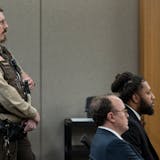Anyone who’s seen the original 1977 “Star Wars: A New Hope” can recognize the blaring brass fanfare of its iconic theme song.
But in a new version of the film, screening at Minnesota theaters this week, Obi-Wan Kenobi’s famous line, “Gi-ga-miinigoz Mamaandaawiziwin,” may not be as familiar as “May the Force be with you.”
The Ojibwe-language version of “Star Wars” recently debuted in Winnipeg, after several Canadian tribal and government groups worked with Disney/Lucasfilm to dub one of Hollywood’s most popular films into the endangered language.
Several of the film’s voice actors have local ties. Dustin Morrow, a University of Minnesota linguistics doctoral student, voiced Obi-Wan Kenobi and Anton Treuer, an author and professor of Ojibwe language at Bemidji State University, spoke lines for some stormtroopers and a loudspeaker announcement in the movie.
For Morrow, hearing his Ojibwe words synced up with the blockbuster he’s seen so many times on TV and VHS was surreal. “This is just such an awesome way to celebrate our Anishinaabe people,” he said.
Ojibwe, or Anishinaabemowin, is the second-most-popular Indigenous language in Canada, but Minnesota is home to the largest population of speakers in the United States.
Revitalization of Indigenous languages is a multipronged effort, involving everything from immersion preschools to apps. But mass media — especially pop culture icons like “Star Wars” — can be a powerful tool in broadening the language’s audience and keeping it relevant.
“I think we’re either going to get TV, Xbox, movies and streaming in our language, or we’re going to lose it,” said Treuer, who is a contributor to Strib Voices. “A language has to be available, not just for science or religion, or it will end up like Latin. It has to be for everything that people want to consume, for their business, daily living and entertainment. It’s a direction that we should be moving in if Ojibwe is going to turn the corner.”

